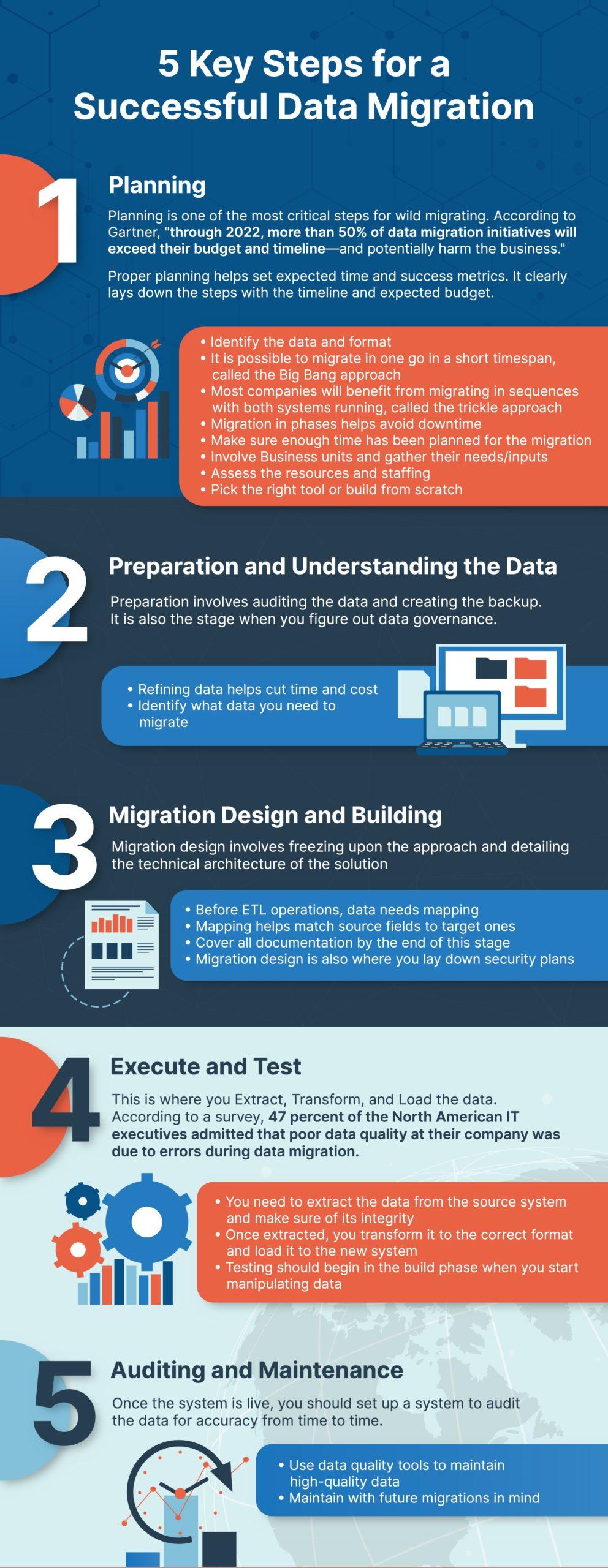You could be migrating storage information or databases from small to large sizes. In any case, you need to plan ahead in data migration, execute with the right strategy, and ensure data accuracy.
Let us walk through the process in this step-by-step breakdown.
-
Planning
Planning is one of the most critical steps for wild migrating. According to Gartner, “through 2022, more than 50% of data migration initiatives will exceed their budget and timeline—and potentially harm the business.”
Proper planning helps set expected time and success metrics. It clearly lays down the steps with the timeline and expected budget.
- Identify the data and format
- It is possible to migrate in one go in a short timespan, called the Big Bang approach
- Most companies will benefit from migrating in sequences with both systems running, called the trickle approach
- Migration in phases helps avoid downtime
- Make sure enough time has been planned for the migration
- Involve Business units and gather their needs/inputs
- Assess the resources and staffing
- Pick the right tool or build from scratch

-
Preparation and Understanding the Data
Preparation involves auditing the data and creating the backup. It is also the stage when you figure out data governance.
- Refining data helps cut time and cost
- Identify what data you need to migrate
-
Migration Design and Building
Migration design involves freezing upon the approach and detailing the technical architecture of the solution
- Before ETL operations, data needs mapping
- Mapping helps match source fields to target ones
- Cover all documentation by the end of this stage
- Migration design is also where you lay down security plans
-
Execute and Test
This is where you Extract, Transform, and Load the data. According to a survey, 47 percent of the North American IT executives admitted that poor data quality at their company was due to errors during data migration.
- You need to extract the data from the source system and make sure of its integrity
- Once extracted, you transform it to the correct format and load it to the new system
- Testing should begin in the build phase when you start manipulating data
-
Auditing and Maintenance
Once the system is live, you should set up a system to audit the data for accuracy from time to time.
- Use data quality tools to maintain high-quality data
- Maintain with future migrations in mind
Data migration is essential when moving to a cloud-centric environment, which is the current trend. Use data migration to get better performance and competitive advantage.
 SOURCES
SOURCES
https://www.bloorresearch.com/technology/data-movement/#emergingtrends
https://www.oracle.com/technetwork/middleware/oedq/successful-data-migration-wp-1555708.pdf
https://www.talend.com/resources/understanding-data-migration-strategies-best-practices/
https://easternpeak.com/blog/7-key-steps-to-perform-a-successful-data-migration/
https://zipreporting.com/en/data-migration/data-migration-process.html
Recent Posts
Let's Talk
Our GoDgtl team is ready to help you!
We appreciate your interest in GoDgtl. Please select which team of experts you wish to engage:
 SOURCES
SOURCES